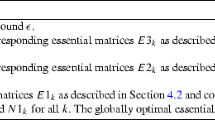
Access this book
Tax calculation will be finalised at checkout
Other ways to access
About this book
Similar content being viewed by others
Keywords
Table of contents (9 chapters)
-
Front Matter
-
Back Matter
Authors and Affiliations
Bibliographic Information
Book Title: Epipolar Geometry in Stereo, Motion and Object Recognition
Book Subtitle: A Unified Approach
Authors: Gang Xu, Zhengyou Zhang
Series Title: Computational Imaging and Vision
DOI: https://doi.org/10.1007/978-94-015-8668-9
Publisher: Springer Dordrecht
-
eBook Packages: Springer Book Archive
Copyright Information: Springer Science+Business Media Dordrecht 1996
Hardcover ISBN: 978-0-7923-4199-4Published: 30 September 1996
Softcover ISBN: 978-90-481-4743-4Published: 15 December 2010
eBook ISBN: 978-94-015-8668-9Published: 09 March 2013
Series ISSN: 1381-6446
Edition Number: 1
Number of Pages: XIX, 316
Topics: Computer Imaging, Vision, Pattern Recognition and Graphics, Electrical Engineering, Image Processing and Computer Vision, Computer Graphics, Mechanical Engineering



